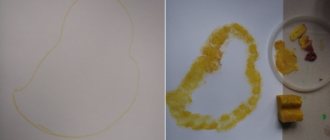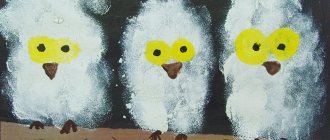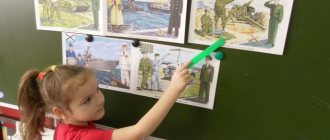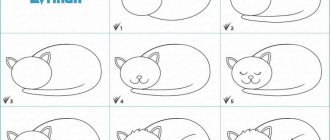How to draw a dandelion with paints step by step for children
Master class on drawing for children 4-6 years old “Dandelion”
Author: Victoria Aleksandrovna Ostanina, teacher of the Children's Preschool Educational Institution DS KV "Rainbow" JV "Silver Hoof" Purpose: Performing a drawing using an unconventional technique. Objectives: - get acquainted with an unconventional drawing technique - the “poke” method; — develop creative abilities; — learn to be careful when working with gouache. Purpose: This master class will be useful for educators, additional education teachers, and primary school teachers. It can also be used by creative people and parents who independently study with their children. Description: The master class gives you the opportunity to draw a flower yourself - a dandelion. Does not require special artistic skills. A detailed description and step-by-step photos will make the drawing process easy and effective. Materials: A4 sheet, gouache, water glass, cotton napkin, brush No. 5 bristles, brushes No. 3, No. 5 (goat, squirrel).
Progress: Summer! Summer! Summer is around! So many bright colors, fragrant herbs and colorful flowers. The beauty of the Ural nature is simply mesmerizing! Sineva cornflowers,
sunny beauty of dandelions,
delicate white daisies!!!
How many fragrant herbs, crackling grasshoppers and humming dragonflies... Today we will draw.... A riddle will tell us what we draw! “In childhood, with a yellow head, In youth, completely gray-haired, But he never gets old, He flies away in white fluff!” (E. Telushkina) Of course it’s a dandelion! He's so handsome!
Dandelion is familiar to us as a small sun and white fluff.
And if you blow on it, it will fly apart.
And its seeds scatter far around. You and I will draw a dandelion like this:
Or maybe not exactly like that, let’s add some white dandelions! For work we need a white sheet of paper, gouache, three brushes: ordinary squirrel brushes No. 3 and No. 6, and hard bristles No. 5, a glass of water and a cloth napkin.
We will draw the stem and leaves in the usual, familiar way. But the flowers are made using an unconventional method - the “poke” method. This method is used for drawing furry animals, flowers, images of snow, fireworks. It is unusual in that before starting to paint you should not dip the brush in water; this is a dry method of painting. We immediately dip a dry brush into gouache, it is most suitable, but we must remember that the gouache should be thick and not dry. You only need to dip the tip of the brush into the gouache. We hold the brush strictly vertically, apply the design by applying the brush to the sheet, as if “poking” into it. Hence the name - the “poke” method. We make the first “poke” on an additional sheet so that subsequent “poke”s are of a uniform color. The space designated for the flower should be filled evenly, placing the “pokes” close to each other, trying not to leave gaps and without overlapping them. And one more little secret: the end of the brush needs to be trimmed a little so that it is flat, not rounded or sharp, but straight. Then the “poke” will be fluffier. I suggest trying it on an additional sheet, making a few pokes, filling out an imaginary form. Have you tried it? Then go ahead! Towards creativity! Progress:
1. Let's make the background. We need brush No. 5, blue gouache, water. Wet the sheet with water using a brush and apply the color evenly. We try to leave the edge of the sheet white on all sides - this will be the frame.
Let the sheet dry. The background is ready. 2. Place the sheet vertically. With brush No. 3 we draw the stems.
3. Now the leaves. First we draw the outline.
Now let's fill it with color.
4. Now we will draw a yellow dandelion. We need a bristle brush and yellow gouache. Don’t forget the features of the “poke” method and start drawing a flower. Remember, the brush is positioned strictly vertically in relation to the sheet! And “poke”, “poke”, “poke”!
Here is our living sun!
5. Draw a fluffy dandelion with white gouache.
And another fluffy one.
Let's decorate the leaves with a thin brush along the contour. The work is ready!
You can draw other versions of the dandelion.
This is how they look together.
And here is a field of dandelions.
My kids immediately noticed these works on the wall in the group and wanted to draw too! I want to present you the best work! It was performed by Ekaterina Ermakova. She is only five years old, but she did her job completely on her own! This is her dandelion!!!
We created a mini-exhibition in the group!
Beautiful? Join us! Create like us, do better than us!
We recommend watching:
Hand drawing for children 3-7 years old. Dandelions How to draw lilies of the valley with gouache step by step Drawing for children 8-10 years old. Bouquet of daisies step by step with photos Master class on drawing for children 5-7 years old “Fairytale flowers in a lace frame” step by step with photos
Similar articles:
Drawing lesson for children 6-7 years old. Drawing Dandelions
Drawing dandelions in the preparatory group
Progress of the lesson
Org. moment.
All the children gathered in a circle, I am your friend and you are my friend. Hold hands tightly and smile at each other.
Let's all smile and share the good mood with each other and with our guests.
Game "Gather flowers by color."
- Guys, what time of year is it now?
– And colorful flowers bloomed in our meadow. I have geometric shapes on my table. What kind of figure is this?
– red circle, blue triangle, yellow square.
- That's right, well done!
– Take one flower at a time and place blue flowers on the table where the blue triangle is, red flowers where the red circle is, yellow flowers on the table where the yellow square is. Let's check.
- Guys, how many flowers have we collected?
In spring, all nature wakes up from a long sleep.
Which flowers bloom first?
– Snowdrops, coltsfoot, dandelions. Dandelion is a medicinal plant, healing and very useful. Its leaves, which contain many vitamins, can be used in salads, and jam can be made from dandelion flowers. Dandelion blooms from early spring to late autumn, in almost any conditions. Before rain and in the evening it closes, in dry weather it opens. Dandelion is not always yellow; time passes, and its flowers turn white, like fluffy balls. You can blow on them and they will fly like little parachutes.
Look how beautiful the dandelion is. How is this flower similar to the sun?
D: Same round and yellow.
Q: What does a dandelion have?
– stem, leaves, flower.
Hear someone buzzing. Who is this?
A winged fashionista, a striped dress, even if she's a little tall, if she bites, it will be bad!
D: Bee.
Q: Hello, bee! What is your name?
The bee found out that a dandelion appeared in our group. She woke up early, and the flowers had not yet bloomed anywhere. The bee really wants to taste the nectar. So she came to us.
Q: A bee needs to collect a lot of flower nectar. Where can we get it?
D: Draw.
Physical education minute.
Before we get started, we'll play with you.
UMC. Disc No. 1, slide No. 13 “Kaida bezne kullarybyz?”
Sit at the table.
– Today we will draw with cotton swabs. We hold the cotton swab in our right hand with three fingers. See how you draw. Place green paint on a cotton swab and draw a straight line. This is the stem of the flower, and to draw a leaf we will also draw a short line. We have drawn the stem and leaves, now let’s draw a flower. To do this, put yellow paint on another cotton swab, put a bright yellow dot on the sheet, and then there are many dots around it in a circle (the explanation is accompanied by an example).
So the flower turned out to be yellow and fluffy.
Look, another dandelion has grown in our group. Now draw the dandelions yourself. Take your sticks and start drawing.
CHILDREN DRAW.
Q: What wonderful flowers they turned out to be. A golden meadow has grown in our group. The bees will sit on it and drink sweet nectar!
Reflection.
Well done boys. Do you want to turn into flowers?
Exercise "Flower".
He says to the flower, flower: pick up your leaf. Go out onto the path and stamp your foot. Shake your head and greet the sun in the morning. Tilt the stem slightly, here is a charge for the flower. Now wash yourself with dew, rest and calm down. Finally everyone is ready to greet the day in all its glory.
Guys, what did we draw today?
- dandelions.
Maya the bee has prepared bee coloring books for you.
All the guys did their best, Maya the bee is very happy.
Altynay Murzabaeva
Summary of a drawing lesson in the middle group
“
Dandelion in the clearing ”
.
Goal: learn to convey the image of a dandelion
;
practice the ability to squeeze excess water from the brush on the edge of the dish; consolidate drawing
by applying the entire brush and using the poking method; develop a sense of color, develop fine motor skills; cultivate a caring attitude towards nature; cultivate a sense of friendship and respect for each other.
Materials: green paper, yellow gouache, large brushes, napkins for each child, a water container, a painting of dandelions
.
Summary of a lesson on speech development in the middle group “Making a story based on a picture”
Elena Sorokina
Summary of a lesson on speech development in the middle group “Making a story based on a picture”
Target. Expand children's understanding of the genres of fine art.
Program content. Educational, developmental , educational tasks.
1. Introduce children to the picture I. Levitan "Dandelions"
.
2. Exercise children in the ability to make sentences , based on the teacher’s questions.
Developmental:
1. Develop coherent speech.
2. Expand children's vocabulary.
1. Cultivate curiosity and interest in art forms.
Planned result. Getting to know Isaac Levitan's painting “Dandelions”
. Formation of the ability to work with words. Expanding ideas about the genres of fine art.
Methods: visual, practical, verbal.
Techniques: teacher's story , use of a reproduction of a painting by I. Levitan "Dandelions"
, question-answer, display, use of artistic words.
Vocabulary work. Picture , dandelions, yellow, fluffy, hats.
Preliminary work. to know the painting by I. Levitan "Dandelions"
. Conversation about genres of fine art.
Equipment. Reproduction of by I. Levitan "Dandelions"
.
How to draw dandelions with children: step-by-step description and photos
Step 1
Paint the stems of dandelion flowers with dark green paint.
Step 2
Draw 2 dandelion leaves on stems. Dandelion leaves look like triangles emerging from one another.
Show your child a picture of a dandelion and look at its leaves.
Step 3
Draw circles on the tops of the stems—the cores for the flower. For those flowers that you plan to draw faded, draw grey-brownish cores, and for blooming dandelions - green.
Step 4
Place white dots around the cores of the dandelions - imprints with ear sticks. You can make several dots that break away from the core and fly through the air.
Step 5
Lightly dip the opposite side of the stick into yellow paint and, using light pressure, draw yellow dandelion petals. The movement of the stick comes from the core with pressure and gradual separation.
The drawing is ready! Have a nice summer everyone! Despite the fact that in many regions it is cold and rainy this year, we can be pleased with pictures with such sunny flowers! Good luck in your creativity and have a nice summer holiday!
Here are the drawings that preschoolers produced from this master class. Drawings by Daryana (5 years old) and Vika (5.5 years old).










